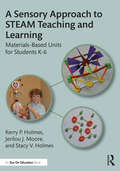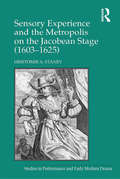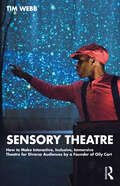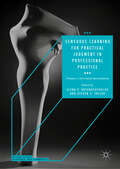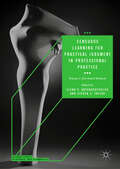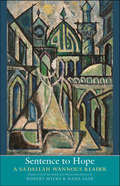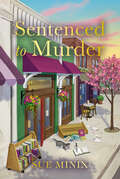- Table View
- List View
Sensing the Nation's Law: Historical Inquiries into the Aesthetics of Democratic Legitimacy (Studies in the History of Law and Justice #13)
by Stefan Huygebaert Angela Condello Sarah Marusek Mark AntakiThis book examines how the nation – and its (fundamental) law – are ‘sensed’ by way of various aesthetic forms from the age of revolution up until our age of contested democratic legitimacy. Contemporary democratic legitimacy is tied, among other things, to consent, to representation, to the identity of ruler and ruled, and, of course, to legality and the legal forms through which democracy is structured. This book expands the ways in which we can understand and appreciate democratic legitimacy. If (democratic) communities are “imagined” this book suggests that their “rightfulness” must be “sensed” – analogously to the need for justice not only to be done, but to be seen to be done. This book brings together legal, historical and philosophical perspectives on the representation and iconography of the nation in the European, North American and Australian contexts from contributors in law, political science, history, art history and philosophy.
Sensing the Past: Hollywood Stars and Historical Visions
by Jim CullenHow do perceptions of the past--not just of particular events, but of the trajectory of history as a whole--shape our experience of the world? Sensing the Past tackles this question with an unlikely source of historical insight--the work of six major Hollywood stars: Clint Eastwood, Daniel Day-Lewis, Denzel Washington, Tom Hanks, Meryl Streep, and Jodie Foster. By focusing on the career choices made by these iconic actors, Cullen uncovers a discrete set of historical narratives, revealing the surprising ways historical forces shape our understanding of the world.
Sensitive Subjects: The Political Aesthetics of Contemporary German and Austrian Cinema (Film Europa #23)
by Leila MukhidaBoth politically and aesthetically, the contemporary German and Austrian film landscape is a far cry from the early days of the medium, when critics like Siegfried Kracauer produced foundational works of film theory amid the tumult of the early twentieth century. Yet, as Leila Mukhida demonstrates in this innovative study, the writings of figures like Kracauer and Walter Benjamin in fact remain an undervalued tool for understanding political cinema today. Through illuminating explorations of Michael Haneke, Valeska Grisebach, Andreas Dresen, and other filmmakers of the post-reunification era, Mukhida develops an analysis centered on film aesthetics and experience, showing how medium-specific devices like lighting, sound, and mise-en-scène can help to cultivate political sensitivity in spectators.
Sensor Based Intelligent Robots: International Workshop Dagstuhl Castle, Germany, September 28 - October 2, 1998 Selected Papers (Lecture Notes in Computer Science #1724)
by Henrik I. Christensen Horst Bunke Hartmut NoltemeierSensor Based Intelligent Robots: International Workshop, Dagstuhl Castle, Germany, October 15-20, 2000. Selected Revised Papers (Lecture Notes in Computer Science #2238)
by Gregory D. Hager Henrik I. Christensen Horst Bunke Rolf KleinRobotics is a highly interdisciplinary research topic, that requires integration of methods for mechanics, control engineering, signal processing, planning, gra- ics, human-computer interaction, real-time systems, applied mathematics, and software engineering to enable construction of fully operational systems. The diversity of topics needed to design, implement, and deploy such systems implies that it is almost impossible for individual teams to provide the needed critical mass for such endeavors. To facilitate interaction and progress on sensor-based intelligent robotics inter-disciplinary workshops are necessary through which - depthdiscussioncanbeusedforcrossdisseminationbetweendi?erentdisciplines. The Dagstuhl foundation has organized a number of workshops on Mod- ing and Integration of Sensor Based Intelligent Robot Systems. The Dagstuhl seminars take place over a full week in a beautiful setting in the Saarland in Germany. The setting provides an ideal environment for in-depth presentations and rich interaction between the participants. This volume contains papers presented during the fourth workshop held - tober 15–20, 2000. All papers were submitted by workshop attendees, and were reviewed by at least one reviewer. We wish to thank all of the reviewers for their invaluable help in making this a high-quality selection of papers. We gratefully acknowledge the support of the Schloss Dagstuhl Foundation and the sta? at Springer-Verlag. Without their support the production of this volume would not have been possible.
Sensorische Regime: Die wahrnehmungsformierende Kraft des Films (Film und Bewegtbild in Kultur und Gesellschaft)
by Johannes GengJohannes Geng geht der Frage nach, inwiefern der Film als technologisches Leitmedium des 20. Jahrhunderts auf die geschichtliche Bedingtheit des Sehens und Hörens zu beziehen ist, indem er in einem ersten Schritt den zugehörigen film- und kulturtheoretischen Diskurs systematisch aufarbeitet. Darüber kommt er zu dem filmtheoretischen Modell eines Sensorischen Regimes, das er dann an zwei Fallstudien – dem NS-Propagandafilm und dem Direct Cinema – exemplifiziert. In unserem Wahrnehmen leiten uns kulturell geformte Gewohnheiten, Erwartungen und Einstellungen. Damit ist Wahrnehmung mehr als nur ein biologischer Mechanismus, sondern historisch variabel.
Sensory Affect, Learning Spaces, and Design Education: Strategies for Reflective Teaching and Student Engagement in Higher Education
by Lorraine MarshalseyThrough the lens of sensory affect, this book offers a new way of thinking about day-to-day teaching and student engagement within learning spaces in design education. The book examines the definitions, concepts, ideas and overlaps of a repertoire of learning spaces prevalent in higher education and addresses the pedagogical gap that exists between broader learning structures and spaces, and the requirements of specialist design education. Recognising that mainstream teaching environments impact upon design studio learning and student engagement, the book positions creative learning spaces at the heart of practice-based learning. It defines the underlying pedagogical philosophy of a creative learning space in design education and reports on how practical strategies incorporating sensory affect may be implemented by educators to foster better student engagement in these spaces within higher education. Bringing much-needed attention to specialist design teaching and learning spaces in higher education, this book will be of interest to educators, researchers and post graduate students immersed in design education, pedagogy, and learning spaces more broadly.
Sensory Affect, Learning Spaces, and Design Education: Strategies for Reflective Teaching and Student Engagement in Higher Education
by Lorraine MarshalseyThrough the lens of sensory affect, this book offers a new way of thinking about day-to-day teaching and student engagement within learning spaces in design education. The book examines the definitions, concepts, ideas and overlaps of a repertoire of learning spaces prevalent in higher education and addresses the pedagogical gap that exists between broader learning structures and spaces, and the requirements of specialist design education. Recognising that mainstream teaching environments impact upon design studio learning and student engagement, the book positions creative learning spaces at the heart of practice-based learning. It defines the underlying pedagogical philosophy of a creative learning space in design education and reports on how practical strategies incorporating sensory affect may be implemented by educators to foster better student engagement in these spaces within higher education. Bringing much-needed attention to specialist design teaching and learning spaces in higher education, this book will be of interest to educators, researchers and post graduate students immersed in design education, pedagogy, and learning spaces more broadly.
A Sensory Approach to STEAM Teaching and Learning: Materials-Based Units for Students K-6
by Kerry P. Holmes Jerilou J. Moore Stacy V. HolmesDid you know you have the power and the materials at your fingertips to facilitate the actual brain growth of students?This book is a practical resource to engage K-6 students with STEAM content through their five senses: seeing, listening, touch/movement, smell and taste. It combines historical research, practical suggestions, and current practices on the stages of cognitive development and the brain’s physical response to emotion and novelty; to help you learn ways to transform ordinary lesson plans into novel and exciting opportunities for students to learn through instruction, exploration, inquiry, and discovery.In addition to providing examples of sensory-rich unit plans, the authors take you through the step-by-step process on how to plan a thematic unit and break it down into daily seamless lesson plans that integrate science, technology, engineering, arts, and mathematics.With 25 themed STEAM unit plans and activities based on national standards, up-to-date research on brain science, and real classroom experience, this book shows multiple ways to develop and deliver active multisensory activities and wow your students with sights and sounds as soon as they come through the door of your classroom.
A Sensory Approach to STEAM Teaching and Learning: Materials-Based Units for Students K-6
by Kerry P. Holmes Jerilou J. Moore Stacy V. HolmesDid you know you have the power and the materials at your fingertips to facilitate the actual brain growth of students?This book is a practical resource to engage K-6 students with STEAM content through their five senses: seeing, listening, touch/movement, smell and taste. It combines historical research, practical suggestions, and current practices on the stages of cognitive development and the brain’s physical response to emotion and novelty; to help you learn ways to transform ordinary lesson plans into novel and exciting opportunities for students to learn through instruction, exploration, inquiry, and discovery.In addition to providing examples of sensory-rich unit plans, the authors take you through the step-by-step process on how to plan a thematic unit and break it down into daily seamless lesson plans that integrate science, technology, engineering, arts, and mathematics.With 25 themed STEAM unit plans and activities based on national standards, up-to-date research on brain science, and real classroom experience, this book shows multiple ways to develop and deliver active multisensory activities and wow your students with sights and sounds as soon as they come through the door of your classroom.
Sensory Experience and the Metropolis on the Jacobean Stage (Studies In Performance And Early Modern Drama Ser.)
by Hristomir A. StanevAt the turn of the seventeenth century, Hristomir Stanev argues, ideas about the senses became part of a dramatic and literary tradition in England, concerned with the impact of metropolitan culture. Drawing upon an archive of early modern dramatic and prose writings, and on recent interdisciplinary studies of sensory perception, Stanev here investigates representations of the five senses in Jacobean plays in relationship to metropolitan environments. He traces the significance of under-examined concerns about urban life that emerge in micro-histories of performance and engage the (in)voluntary and sometimes pre-rational participation of the five senses. With a dominant focus on sensation, he argues further for drama’s particular place in expanding the field of social perception around otherwise less tractable urban phenomena, such as suburban formation, environmental and noise pollution, epidemic disease, and the impact of built-in city space. The study focuses on ideas about the senses on stage but also, to the extent possible, explores surviving accounts of the sensory nature of playhouses. The chapters progress from the lower order of the senses (taste and smell) to the higher (hearing and vision) before considering the anomalous sense of touch in Platonic terms. The plays considered include five city comedies, a romance, and two historical tragedies; playwrights whose work is covered include Shakespeare, Jonson, Webster, Fletcher, Dekker, and Middleton. Ultimately, Stanev highlights the instrumental role of sensory flux and instability in recognizing the uneasy manner in which the London writers, and perhaps many of their contemporaries, approached the rapidly evolving metropolitan environment during the reign of King James I.
Sensory Experience and the Metropolis on the Jacobean Stage (1603–1625)
by Hristomir A. StanevAt the turn of the seventeenth century, Hristomir Stanev argues, ideas about the senses became part of a dramatic and literary tradition in England, concerned with the impact of metropolitan culture. Drawing upon an archive of early modern dramatic and prose writings, and on recent interdisciplinary studies of sensory perception, Stanev here investigates representations of the five senses in Jacobean plays in relationship to metropolitan environments. He traces the significance of under-examined concerns about urban life that emerge in micro-histories of performance and engage the (in)voluntary and sometimes pre-rational participation of the five senses. With a dominant focus on sensation, he argues further for drama’s particular place in expanding the field of social perception around otherwise less tractable urban phenomena, such as suburban formation, environmental and noise pollution, epidemic disease, and the impact of built-in city space. The study focuses on ideas about the senses on stage but also, to the extent possible, explores surviving accounts of the sensory nature of playhouses. The chapters progress from the lower order of the senses (taste and smell) to the higher (hearing and vision) before considering the anomalous sense of touch in Platonic terms. The plays considered include five city comedies, a romance, and two historical tragedies; playwrights whose work is covered include Shakespeare, Jonson, Webster, Fletcher, Dekker, and Middleton. Ultimately, Stanev highlights the instrumental role of sensory flux and instability in recognizing the uneasy manner in which the London writers, and perhaps many of their contemporaries, approached the rapidly evolving metropolitan environment during the reign of King James I.
Sensory Theatre: How to Make Interactive, Inclusive, Immersive Theatre for Diverse Audiences by a Founder of Oily Cart
by Tim WebbSensory Theatre: How to Make Interactive, Inclusive, Immersive Theatre for Diverse Audiences by a Founder of Oily Cart is an accessible step-by-step guide to creating theatre for inclusive audiences, such as young people on the autism spectrum or affected by other neuro-divergent conditions and children under two. Conventional theatre relies on seeing and hearing to involve its audience; sensory theatre harnesses the power of five or more senses to address its participants who have different ways of relating to the world around them. This book is an insightful history of Oily Cart and its pioneering development of work for the very young, including Baby Theatre, and for neuro-divergent audiences including those on the autism spectrum. It gives a clear introduction to the fundamental concepts of this theatre, suggests a host of practical techniques drawn from over forty years of experience, and describes some of Oily Cart’s most radical innovations, including theatre on trampolines, in hydrotherapy pools, and with flying audiences in the company of aerial artists. The book also includes copious photos from the Oily Cart’s archives and links to videos examples of the company’s work. Readers will learn how to: Research the intended audience while not being led astray by labels. Create a welcoming, immersive sensory space in classrooms, nurseries, school halls, and playgrounds. Devise sensory stories that can be adapted to suit different audiences. Recruit, audition, cast, and run rehearsals. Ensure that the production is truly sensory and interactive. Written for Theatre for Young Audiences, Drama in Education, and specialized Applied Theatre courses, as well as educators and theatre practitioners interested in creating inclusive, interactive productions, Sensory Theatre offers a goldmine of ideas for making work that connects with audiences who can be the hardest to reach.
Sensory Theatre: How to Make Interactive, Inclusive, Immersive Theatre for Diverse Audiences by a Founder of Oily Cart
by Tim WebbSensory Theatre: How to Make Interactive, Inclusive, Immersive Theatre for Diverse Audiences by a Founder of Oily Cart is an accessible step-by-step guide to creating theatre for inclusive audiences, such as young people on the autism spectrum or affected by other neuro-divergent conditions and children under two. Conventional theatre relies on seeing and hearing to involve its audience; sensory theatre harnesses the power of five or more senses to address its participants who have different ways of relating to the world around them. This book is an insightful history of Oily Cart and its pioneering development of work for the very young, including Baby Theatre, and for neuro-divergent audiences including those on the autism spectrum. It gives a clear introduction to the fundamental concepts of this theatre, suggests a host of practical techniques drawn from over forty years of experience, and describes some of Oily Cart’s most radical innovations, including theatre on trampolines, in hydrotherapy pools, and with flying audiences in the company of aerial artists. The book also includes copious photos from the Oily Cart’s archives and links to videos examples of the company’s work. Readers will learn how to: Research the intended audience while not being led astray by labels. Create a welcoming, immersive sensory space in classrooms, nurseries, school halls, and playgrounds. Devise sensory stories that can be adapted to suit different audiences. Recruit, audition, cast, and run rehearsals. Ensure that the production is truly sensory and interactive. Written for Theatre for Young Audiences, Drama in Education, and specialized Applied Theatre courses, as well as educators and theatre practitioners interested in creating inclusive, interactive productions, Sensory Theatre offers a goldmine of ideas for making work that connects with audiences who can be the hardest to reach.
Sensualities/Textualities and Technologies: Writings of the Body in 21st Century Performance (Palgrave Studies In Performance And Technology Ser.)
by Susan Broadhurst Josephine MachonThis innovative collection features essays by a range of internationally renowned scholars and reconsiders textual practices in contemporary performance, specifically focusing on the exciting exchange between text, body and technology.
Sensuous Cinema: The Body in Contemporary Maghrebi Film (Thinking Cinema)
by Kaya Davies HayonSensuous Cinema: The Body in Contemporary Maghrebi Film examines a cluster of recent films that feature Maghrebi(-French) people and position corporeality as a site through which subjectivity and self-other relations are constituted and experienced. These films are set in and between the countries of the Maghreb, France and, to a lesser degree, Switzerland, and often adopt a sensual aesthetic that prioritizes embodied knowledge, the interrelation of the senses and the material realities of emotional experience. However, despite the importance of the body in these films, no study to date has taken corporeality as its primary point of concern. This new addition to the Thinking Cinema series interweaves corporeal phenomenology with theological and feminist scholarship on the body from the Maghreb and the Middle East to examine how Maghrebi(-French) people of different genders, ethnicities, sexualities, ages and classes have been represented corporeally in contemporary Maghrebi and French cinemas. Via detailed textual and phenomenological analyses of films such as Red Satin (Amari 2002), Exiles (Gatlif 2004), Couscous (Kechiche 2007) and Salvation Army (Taïa 2014), Kaya Hayon Davies conveys the pivotal role that corporeality plays in articulating identity and the emotions in these films.
Sensuous Cinema: The Body in Contemporary Maghrebi Film (Thinking Cinema)
by Kaya Davies HayonSensuous Cinema: The Body in Contemporary Maghrebi Film examines a cluster of recent films that feature Maghrebi(-French) people and position corporeality as a site through which subjectivity and self-other relations are constituted and experienced. These films are set in and between the countries of the Maghreb, France and, to a lesser degree, Switzerland, and often adopt a sensual aesthetic that prioritizes embodied knowledge, the interrelation of the senses and the material realities of emotional experience. However, despite the importance of the body in these films, no study to date has taken corporeality as its primary point of concern. This new addition to the Thinking Cinema series interweaves corporeal phenomenology with theological and feminist scholarship on the body from the Maghreb and the Middle East to examine how Maghrebi(-French) people of different genders, ethnicities, sexualities, ages and classes have been represented corporeally in contemporary Maghrebi and French cinemas. Via detailed textual and phenomenological analyses of films such as Red Satin (Amari 2002), Exiles (Gatlif 2004), Couscous (Kechiche 2007) and Salvation Army (Taïa 2014), Kaya Hayon Davies conveys the pivotal role that corporeality plays in articulating identity and the emotions in these films.
Sensuous Learning for Practical Judgment in Professional Practice: Volume 2: Arts-based Interventions (Palgrave Studies in Business, Arts and Humanities)
by Elena P. Antonacopoulou Steven S. TaylorThe second volume of this ground-breaking book critically examines the effect of arts-based methods in combination as arts-based interventions in improving professional practice, from deinstitutionalization to the counteraction of destructive leadership. Taking a ‘human-centred’ approach, it delivers an insightful account of what these approaches do differently to achieve a new mode of learning – ‘sensuous learning’ – that cultivates professional judgment to serve the common good, simultaneously supporting personal and collective growth. The chapters present cutting edge examples of multiple ways arts-based interventions underpin learning arenas for expanding leadership and improving professional practice. The reflexivity cultivated through these learning arenas has the unique potential to improve professional practice, not merely by enhancing competence but also by cultivating character and conscience, which is central in making judgments that serve the common good. These benefits are relevant for professional practitioners sharpening the skills and behaviours needed in organisations, including creativity, diversity, imagination, and improvisation.
Sensuous Learning for Practical Judgment in Professional Practice: Volume 1: Arts-based Methods (Palgrave Studies in Business, Arts and Humanities)
by Elena P. Antonacopoulou Steven S. TaylorThe first volume of this ground-breaking book critically examines how and why arts-based methods such as choir conducting workshops and dialogue improvisation can make a difference in improving professional practice. Taking a ‘human-centred’ approach, it delivers an insightful account of what these approaches do differently to achieve a new mode of learning – ‘sensuous learning’ – that cultivates professional judgment to serve the common good, simultaneously supporting personal and collective growth. The chapters present cutting edge examples of multiple ways arts-based methods underpin learning arenas for expanding leadership and improving professional practice. The reflexivity cultivated through these learning arenas has the unique potential to improve professional practice, not merely by enhancing competence but also by cultivating character and conscience, which is central in making judgments that serve the common good. These benefits are relevant for professional practitioners sharpening the skills and behaviours needed in organisations, including creativity, diversity, imagination, and improvisation.
A Sentence a Day: Short, Playful Proofreading Exercises to Help Students Avoid Tripping Up When They Write (Grades 6-9)
by Samantha PrustMany teachers have adopted the daily proofreading exercises published by large companies as a way to help students practice finding and correcting errors. Sadly, many students have fallen asleep over these same exercises.Ordinary daily proofreading exercises try to do too much—i.e., force-feed facts and information as they also try to teach writing. A Sentence a Day takes a different approach. It focuses on short, playful, interesting sentences with a sense of humor. Students receive proofreading practice in daily doses that don't overwhelm. Each exercise should take only a few minutes of class time, allowing for frequent, consistent reinforcement and practice of serious writing skills.Each page of the book shows an incorrect sentence, a sample correction, and notes for the teacher.Grades 6-9
A Sentence a Day: Short, Playful Proofreading Exercises to Help Students Avoid Tripping Up When They Write (Grades 6-9)
by Samantha PrustMany teachers have adopted the daily proofreading exercises published by large companies as a way to help students practice finding and correcting errors. Sadly, many students have fallen asleep over these same exercises.Ordinary daily proofreading exercises try to do too much—i.e., force-feed facts and information as they also try to teach writing. A Sentence a Day takes a different approach. It focuses on short, playful, interesting sentences with a sense of humor. Students receive proofreading practice in daily doses that don't overwhelm. Each exercise should take only a few minutes of class time, allowing for frequent, consistent reinforcement and practice of serious writing skills.Each page of the book shows an incorrect sentence, a sample correction, and notes for the teacher.Grades 6-9
A Sentence a Day: Short, Playful Proofreading Exercises to Help Students Avoid Tripping Up When They Write (Grades 6-9)
by Samantha PrustA Sentence a Day is not your average grammar workbook. Focusing on short, playful, interesting sentences with a sense of humor, these proofreading exercises help students learn without feeling overwhelmed.This new edition features 50 new exercises and interactive elements in its ebook+ version! Each exercise should take only a few minutes of class time, allowing for frequent, consistent reinforcement and practice of serious writing skills. Each exercise shows an incorrect sentence, a sample correction, and explanatory notes for the teacher.With a wide range of difficulty throughout the lessons, this book is a great resource for middle school students, high school students, or anyone looking to improve their writing and grammar skills.
A Sentence a Day: Short, Playful Proofreading Exercises to Help Students Avoid Tripping Up When They Write (Grades 6-9)
by Samantha PrustA Sentence a Day is not your average grammar workbook. Focusing on short, playful, interesting sentences with a sense of humor, these proofreading exercises help students learn without feeling overwhelmed.This new edition features 50 new exercises and interactive elements in its ebook+ version! Each exercise should take only a few minutes of class time, allowing for frequent, consistent reinforcement and practice of serious writing skills. Each exercise shows an incorrect sentence, a sample correction, and explanatory notes for the teacher.With a wide range of difficulty throughout the lessons, this book is a great resource for middle school students, high school students, or anyone looking to improve their writing and grammar skills.
Sentence to Hope: A Sa'dallah Wannous Reader (The Margellos World Republic of Letters)
by Sa'dallah WannousThe first major English-language collection of plays and essays by Syrian playwright Sa'dallah WannousSa'dallah Wannous is acknowledged to be one of the Arab world’s most significant playwrights, writers, and intellectuals of the twentieth century. This is the first major English-language collection that brings together his most significant plays and essays. Selections include the groundbreaking 1969 play An Evening’s Entertainment for the Fifth of June, a scathing indictment of the duplicity of Arab leaders during the 1967 War, as well as Wannous’s most celebrated play, Rituals of Signs and Transformations, a bold treatment of homosexuality, prostitution, clerical corruption, and the quest for female liberation. In addition to his work as a playwright, Wannous, like Brecht, was an astute theatrical and cultural critic, and his essays, some of which are included here, offer shrewd diagnoses of the ills of Arab society and the essential role of theater in ameliorating them.
Sentenced to Murder (The Bookstore Mystery Series)
by null Sue MinixShe’s written murder mysteries before, but can she solve this real life cold case? Just as Jen sits down to start writing her next murder mystery novel, she stumbles across a chilling real-life case: a man who claims he’s been wrongly convicted for murder. Time is running out for Jaylon as he needs a kidney transplant to save his life, something he’ll never receive while he’s in prison for murder. Jen’s amateur sleuthing skills are pushed to their very limit as time is ticking to solve Jaylon’s case and save his life. Can she save him before his sentence to murder becomes a sentence to death? This bookish cozy mystery is perfect for fans of Agatha Christie and Ellery Adams, and will leave you guessing right up until the final page.







